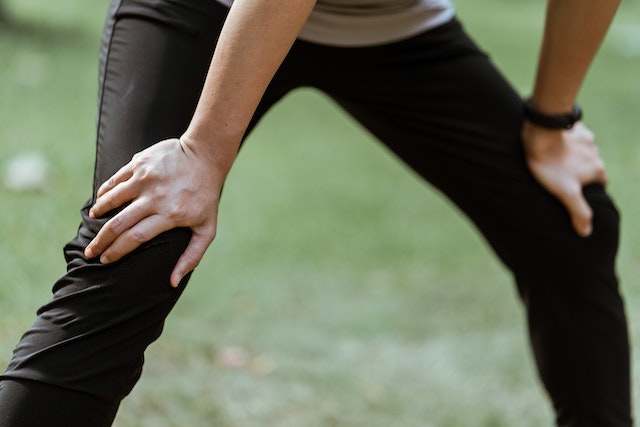Among the problems that we can suffer in our body, there are many that can occur and that affect different parts of it.. In this case we are going to talk about the causes and treatment of hyperextensionóno knee, that although it may be normal, in some cases it can give sísymptoms and have very negative consequences for whoédoes not suffer.
Index
¿Whaté is hyperextensionóno knee?
The hyperextendedóno knee occurs when the knee is extendedás allá from 180 degree or positionón reference zero in the sagittal plane, something that happens as a consequence of the alterationón of different aspects biomecáunique, that usually have to do with the physiological stateóadult play, being simétrico, bilateral, of constitutional origin and withoutíntomas.
Nevertheless, spaghettién can become a cong probleménito the acquired, being in this úlast case, as usual, symptomsático and asimétrico, which in turn means that it should be considered patológico.
Causes of hyperextensionóno knee
The causes that cause the appearanceón of one hyperextendedóno knee depend on the type of genu recurvatum, although alsoéThere are other factors that may have a relationshipón direct with the deformity that can be produced in this part of the body. Among the possible causes we must highlight the following:
- Lower limb length discrepancy.
- To paragraphsón del fémur and tibia is not suitable.
- Presenterón of connective tissue disorders.
- Muscular dystrophy.
- Dorsiflexióno limited.
- Laxity in the knee ligaments.
- weakness of múscull bíceps femoris, poplíteo, gastrocnemius or múextensor muscles of the hip.
- Uniódefective n of the bones surrounding the knee.
- joint instabilityón on the occasion of ligaments and injuries in the cápsula articular.
- Déficit en la propiocepción articular.
- Parálisis cerebral.
Constitutional bent knee
when talking about hyperextendedóno knee we have to find that there are different types of it. The first is the hyperextendedóno constitutional knee, which usually has a áglobal angles lower than those 15 degrees, it's siméthree, bilateral, and usually asymptomaticática. As a general rule, it is given by a constitutional ligamentous hyperlaxity.
On many occasions it has to do with the instability of the rótula, with pseudo róCome from below, of which is one of its secondary factors that is considered to be flattering.
Bended knee congéthis
In this case we find a luxación congénita knee, spaghettién known as arthrogryposis, which can be unilateral or bilateral and occurs infrequently. It is characterized by the fact that there is hyperextendedón of knee greater than 0º, and is linked to the existence of a limitationóno in the flexión.
In this case there is a prominence of the cófemoral indyls in the popl fossaítea, además of an increase in the folds cutátransverse neos on the anterior surface of the knee. Sometimes it is caused by hypermobility that occurs when we are born, and that suffers a regressionón once the a's have passedñthose by means of orthop deviceséindices that cause the knee to be in slight flexionón.
Nevertheless, spaghettiécan not have other causes. In this case you canístill ruled out the existence of abnormalíace of gravity in the neuromuscular system, condodysphthrophies and arthrotryposis congéstrength múmultiples.
Acquired bent knee
When we talk about the hyperextendedóNo. of acquired knee This takes place as a consequence of suffering from an injuryón ligamentous, óeither or mixed knee. In this case, a clinical study should be carried out.ínico radiolólogic in which it is measured and evaluatedúto the part ósea, ya sea tibial o femoral, and then the ligamentous part in the case of a mixed recurvatum.
Sísymptoms of hyperextensionóno knee
The hyperextendedóno knee It can occur at different levels of severity, which implies that the síntomas de la lesiódo not depend on different factors, both of the type of hyperextensionón like the body of each person, without forgetting the total strength of the articulationóno knee.
In any case, orientatively, we can tell you about some of theísymptoms that occur more frequently among people who suffer from hyperextendedóno knee, what are the following:
- PresenteróNo pain in the knees.
- antiest deformationséticks in the knee.
- Tibiofemoral or patellofemoral instability.
- reductionón knee mobility.
- swellings.
- Weakness in the lower limb.
- Difficulty walking on uneven surfaces, así as when carrying out the prásports practice.
- Inequality in the length of the lower limbs.
Treatment for hyperextensionóno knee
Once you know the different sísymptoms and types of hyperextendedóno knee that can be suffered we find ourselves with the need to know cóHow can we manage to deal with this problem that can affect a greater number of people than you might think?.
In this sense, it is necessary to know that the treatment of the hyperextendedóno knee needs a studyínico and radiolócomplete logic of the abnormalíto what the patient suffers, así as well as the possible deformations associated with it., for which the final treatment will dependá of each particular case.
In this way, to beá the physician who has to carry out the diagnosisóstico and evaluate cuáIt is the best way to deal with the problem suffered by the patient so that he can find the solution.óno to your problem.
In any case, we can indicate that, generally, the use of orthopedic devicesédicos and férules, the cuáthey are in charge of limiting the extensionón e prevent the positionón en recurved.
in addition, the use of specially designed knee pads can be usedñadas for hyperextensionóno knee, so that it is an orthosis that limits the range of posterior movement of the knee and the correctionópattern no.óno postural of this, causing the joint to stabilizeón tibiofemoral in the anteroposterior plane, and preventing a position from being reachedón de recurved.
Nevertheless, Sometimes this type of solution is not enough and an intervention is needed.ón wantúrgica.

